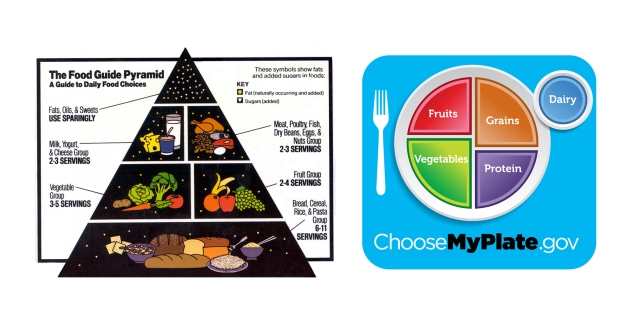In the last 3 years since MyPlate replaced the traditional Food Pyramid, Americans now have clearer guidelines about what they should include in their daily diets. The hierarchy of confusing servings is now clearly depicted by a multi-color plate divided in four – plus a glass of milk.
Throughout January, we’ve been featuring various aspects of MyPlate to make the recommendations even clearer. This week it’s all about that glass – and other MyPlate dairy recommendations.
Interestingly, dairy is not just food made from animal milk, but it can also be plant based, such as soy milk. MyPlate includes dairy foods that retain their full calcium content, plus foods that have little to no calcium, such as cream cheese or butter. The dairy group also includes yogurt, ice cream and puddings.
Besides calcium – which is vital for building bones and teeth – dairy products such as yogurt, milk and soymilk are rich in potassium and Vitamin D, and help maintain healthy blood pressure.
The Food Pyramid suggested 2-3 servings of diary, but didn’t really specify what a serving was. Plus, the graphic only showed cheese, milk and ice cream. MyPlate is much clearer – and makes special recommendations about choosing low-fat dairy options.
Low-fat dairy products offer the same nutritional benefits, but are much better for your health than foods high in saturated fat. Diets high in saturated fats found in regular diary products raise ‘bad’ cholesterol, otherwise known as low-density lipoprotein or LDL. Foods high in LDL increase the risk of coronary disease and weight gain.
Because dairy foods are often creamy and flavorful, it’s very easy to over-consume them. MyPlate has specific recommendations based on age and whether you are male or female.
For example, women and men 31 and older should eat 3 cups of dairy every day, while children 2-3 years should only have 2 cups. These recommendations are based on those who get 30 minutes or less of moderate physical activity, beyond normal daily activities.
While an 8-ounce cup of milk is simple to understand, ounce-equivalents of solid foods like cheese are not always easy to envision. Here are some specific suggestions of what equals 1 cup of these dairy foods:
Yogurt – 1 store container
Sliced Cheese – 3 ounces
Cottage Cheese – 2 cups
Ice Cream – 2 scoops
Here are some tips for making wise dairy choices.
- Make sure to include milk or calcium-fortified soymilk as a beverage at each meal.
- If you drink whole milk, switch gradually to options lower in fat and calories.
- Ask for fat-free milk for your coffee drinks.
- Opt for low-fat yogurt for a snack or in smoothies.
- Make dip for fruit or snacks out of yogurt.
- Choose low-fat cheeses for baked dishes.
- Top baked potatoes with yogurt instead of butter or sour cream.
If you happen to be lactose intolerant, you can still get your daily needs of calcium and minerals from other nutritious foods. Here are some options to get calcium into your diet if you aren’t able to eat dairy foods.
- Drink calcium-fortified juices, rice milk or almond milk.
- Eat calcium-fortified cereals and breads.
- Eat canned fish, such as sardines or salmon
- Add soybeans or other soy products to your diet
- Steam leafy greens, such as collard, turnip, kale or bok choy
Remember – Always opt for a non- or low-fat version of every dairy product. The texture and taste may not appeal to you at first, but within a short time, you won’t notice the taste of the missing fats.
Sources:
http://www.disabled-world.com/artman/publish/food_pyramid.shtml
http://www.nursingdegree.net/blog/746/10-most-pervasive-food-pyramid-myths/
Related Articles
Replacing the Food Pyramid With MyPlate

Join the Discussion
0 Comments